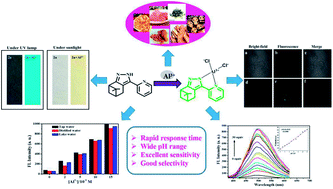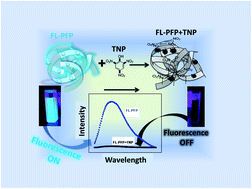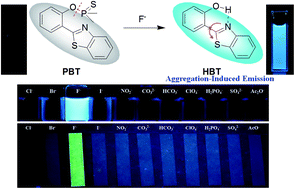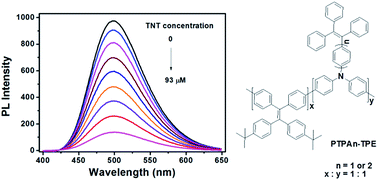Themed collection Editors’ collection: Fluorescent Sensors

A review on graphene-based nanocomposites for electrochemical and fluorescent biosensors
Biosensors with high sensitivity, selectivity and a low limit of detection, reaching nano/picomolar concentrations of biomolecules, are important to the medical sciences and healthcare industry for evaluating physiological and metabolic parameters.

RSC Adv., 2019,9, 8778-8881
https://doi.org/10.1039/C8RA09577A
Recent development of boronic acid-based fluorescent sensors
As Lewis acids, boronic acids can bind with 1,2- or 1,3-diols in aqueous solution reversibly and covalently to form five or six cyclic esters, thus resulting in significant fluorescence changes.

RSC Adv., 2018,8, 29400-29427
https://doi.org/10.1039/C8RA04503H
Skin cancer detection using non-invasive techniques
Recent advances in non-invasive techniques for skin cancer diagnosis.

RSC Adv., 2018,8, 28095-28130
https://doi.org/10.1039/C8RA04164D
Fluorescent carbon dots: rational synthesis, tunable optical properties and analytical applications
This review summarizes current advances on the design and the employment of fluorescent carbon dots in sensing applications, especially from the point of analytical view.

RSC Adv., 2017,7, 40973-40989
https://doi.org/10.1039/C7RA07573A
Fluorescent probes and materials for detecting formaldehyde: from laboratory to indoor for environmental and health monitoring
Formaldehyde (FA), as a vital industrial chemical, is widely used in building materials and numerous living products.

RSC Adv., 2017,7, 36421-36432
https://doi.org/10.1039/C7RA05651F
Efficient solid-state emission and reversible mechanofluorochromism of a tetraphenylethene-pyrene-based β-diketonate boron complex
A new twisted dye (BF2-TP) was synthesized, it possesses distinct mechanofluorochromism with large spectral shift of 62 nm.

RSC Adv., 2019,9, 19641-19647
https://doi.org/10.1039/C9RA03847G
One-pot construction of diverse and functionalized isochromenoquinolinediones by Rh(III)-catalyzed annulation of unprotected arylamides with 3-diazoquinolinediones and their application for fluorescence sensor
An efficient Rh(III)-catalyzed annulation of arylamides with 3-diazoquinolinediones for the construction of diverse and highly functionalized isochromenoquinolinedione derivatives is described.

RSC Adv., 2019,9, 17347-17357
https://doi.org/10.1039/C9RA03146D
Carboxylato-pillar[6]arene-based fluorescent indicator displacement assays for the recognition of monoamine neurotransmitters
The complexation of three cationic fluorescent dye guests with the anionic host carboxylato-pillar[6]arene (WP6) was investigated by optical and NMR spectroscopy.
![Graphical abstract: Carboxylato-pillar[6]arene-based fluorescent indicator displacement assays for the recognition of monoamine neurotransmitters](/en/Image/Get?imageInfo.ImageType=GA&imageInfo.ImageIdentifier.ManuscriptID=C9RA03241J&imageInfo.ImageIdentifier.Year=2019)
RSC Adv., 2019,9, 16856-16862
https://doi.org/10.1039/C9RA03241J
White light emission from a mixture of silicon quantum dots and gold nanoclusters and its utilities in sensing of mercury(II) ions and thiol containing amino acid
A simple solution based approach for generation of WLEM and its utilities in sensing of Hg2+ ions and cysteine.

RSC Adv., 2019,9, 15997-16006
https://doi.org/10.1039/C9RA02012H
Fluorescent sensor for water based on photo-induced electron transfer and Förster resonance energy transfer: anthracene-(aminomethyl)phenylboronic acid ester-BODIPY structure
An anthracene-(aminomethyl)phenylboronic acid ester-BODIPY (DJ-1) structure was developed as a fluorescent sensor based on photo-induced electron transfer (PET) and Förster resonance energy transfer (FRET) for detection of water in solvents.

RSC Adv., 2019,9, 15335-15340
https://doi.org/10.1039/C9RA02686J
A bis-benzimidazole PMO ratiometric fluorescence sensor exhibiting AIEE and ESIPT for sensitive detection of Cu2+
A novel bis-benzimidazole organic siloxane precursor (BBM-Si) was prepared, and was combined with tetraethylorthosilicate (TEOS) as a mixed Si source.

RSC Adv., 2019,9, 13567-13575
https://doi.org/10.1039/C9RA00892F
Construction of anisotropic fluorescent nanofibers assisted by electro-spinning and its optical sensing applications
Anisotropic fluorescent nanofibers constructed from the self-assembled perylene bisimide derivative and poly(vinylidene fluoride) show high sensitivity and short response time to aniline vapor.

RSC Adv., 2019,9, 12585-12589
https://doi.org/10.1039/C9RA00502A
Mint leaf derived carbon dots for dual analyte detection of Fe(III) and ascorbic acid
Highly luminescent carbon dots (CDs) are obtained from mint leaves adopting a simple and cost effective route devoid of additional chemical reagents and functionalization.

RSC Adv., 2019,9, 12070-12077
https://doi.org/10.1039/C9RA02120E
Ultrasensitive fluorescent aptasensor for CRP detection based on the RNase H assisted DNA recycling signal amplification strategy
An aptamer-based method for the ultrasensitive fluorescence detection of C-reactive protein (CRP) was developed using the ribonuclease H (RNase H) assisted DNA recycling signal amplification strategy.

RSC Adv., 2019,9, 11960-11967
https://doi.org/10.1039/C9RA01352K
Aggregation-induced emission enhancement (AIEE)-active tetraphenylethene (TPE)-based chemosensor for Hg2+ with solvatochromism and cell imaging characteristics
A TPE-based AIEE-active fluorescent sensor for Hg2+ was synthesized. Furthermore, it showed solvatochromism and cell imaging characteristics.

RSC Adv., 2019,9, 11865-11869
https://doi.org/10.1039/C9RA02119A
High resolution tracking of macrophage cells in deep organs and lymphatics using fluorescent polymer dots
Fluorescent polymer dots for tracking macrophage cells in deep organs using probe-based confocal laser endomicroscopy (pCLE).

RSC Adv., 2019,9, 10966-10975
https://doi.org/10.1039/C9RA00954J
A highly sensitive and selective fluorescent probe for quantitative detection of Al3+ in food, water, and living cells
Probe 2a exhibiting high sensitivity, good selectivity, wide pH range, lower detection limit, and rapid detection for Al3+, probe 2a was applied for the successful detection of Al3+ in water samples, food samples and HeLa cells.

RSC Adv., 2019,9, 10414-10419
https://doi.org/10.1039/C9RA00447E
Mechano-fluorochromic behavior of AEE polyurethane films and their high sensitivity to halogen acid gas
(a) Polyurethanes with higher content of TABDAA2 presented better positive correlation between fluorescence and strain. (b) Sensing mechanism of STMPU-50 for detection of HCl.

RSC Adv., 2019,9, 9517-9521
https://doi.org/10.1039/C8RA10486G
Retracted Article: Miscanthus grass-derived carbon dots to selectively detect Fe3+ ions
Fluorescent carbon dots for the selective and sensitive detection of Fe3+ ions with a wide detection range and very low detection limit.

RSC Adv., 2019,9, 8628-8637
https://doi.org/10.1039/C8RA10051A
A highly selective colorimetric fluorescent probe for detection of Hg2+ and its application on test strips
An efficient fluorescent probe Pyr-Rhy based on pyrazole was developed, which can detect Hg2+ in water.

RSC Adv., 2019,9, 8529-8536
https://doi.org/10.1039/C9RA00797K
A novel method for the preparation of solvent-free, microwave-assisted and nitrogen-doped carbon dots as fluorescent probes for chromium(VI) detection and bioimaging
Herein, N-doped carbon dots with excellent fluorescence characteristics were prepared by a solvent-free, microwave-assisted method and employed for the fluorometric detection of Cr(VI) and bioimaging.

RSC Adv., 2019,9, 8230-8238
https://doi.org/10.1039/C9RA00290A
A porous β-cyclodextrin-based terpolymer fluorescence sensor for in situ trinitrophenol detection
Permanent porosity plays a key role in fluorescent-based polymers with “on–off” emissive properties due to the role of guest adsorption at accessible fluorophore sites of the polymer framework.

RSC Adv., 2019,9, 8073-8080
https://doi.org/10.1039/C8RA06192K
Qualitative colorimetric analysis of a Ir(III)/Eu(III) dyad in the presence of chemical warfare agents and simulants on a paper matrix
A dual emissive Ir(III)/Eu(III) dyad in a paper-based luminescence assay for liquid chemical warfare agents demonstrated clear visual responses.

RSC Adv., 2019,9, 7615-7619
https://doi.org/10.1039/C9RA00824A
Upconversion fluorescent nanoparticles based-sensor array for discrimination of the same variety red grape wines
A fluorescent sensor array composed of upconversion nanomaterials to distinguish the same variety of red grape wines was constructed.

RSC Adv., 2019,9, 7349-7355
https://doi.org/10.1039/C8RA09959F
Three resorcin[4]arene-based lanthanide-coordination polymers with multifunctional photoluminescence sensing properties
We report three lanthanide-coordination polymers assembled with a resorcin[4]arene ligand, where 1 and 2 could be applied as fluorescent sensors for N,N′-dimethylformamide and Fe3+ ion.
![Graphical abstract: Three resorcin[4]arene-based lanthanide-coordination polymers with multifunctional photoluminescence sensing properties](/en/Image/Get?imageInfo.ImageType=GA&imageInfo.ImageIdentifier.ManuscriptID=C8RA09777A&imageInfo.ImageIdentifier.Year=2019)
RSC Adv., 2019,9, 3647-3652
https://doi.org/10.1039/C8RA09777A
Phenylboronic acid derivative-modified (6,5) single-wall carbon nanotube probes for detecting glucose and hydrogen peroxide
In this paper, we presented a new method for constructing near-infrared fluorescence probes and their applications in detecting glucose and hydrogen peroxide (H2O2).

RSC Adv., 2019,9, 2258-2267
https://doi.org/10.1039/C8RA09272A
A water-stable luminescent metal–organic framework for effective detection of aflatoxin B1 in walnut and almond beverages
Sensitive and rapid detection of aflatoxin B1 (AFB1) without using antibody or biomolecular modifications in water is achieved using a novel water-stable luminescent metal–organic framework (LMOF) termed Zr-CAU-24.

RSC Adv., 2019,9, 620-625
https://doi.org/10.1039/C8RA07804A
Ultrasensitive electrochemical detection of methyl parathion pesticide based on cationic water-soluble pillar[5]arene and reduced graphene nanocomposite
A promising electrochemical sensing platform for the detection of methyl parathion based on cationic water-soluble pillar[5]arene reduced graphene nanocomposite.
![Graphical abstract: Ultrasensitive electrochemical detection of methyl parathion pesticide based on cationic water-soluble pillar[5]arene and reduced graphene nanocomposite](/en/Image/Get?imageInfo.ImageType=GA&imageInfo.ImageIdentifier.ManuscriptID=C8RA08555B&imageInfo.ImageIdentifier.Year=2019)
RSC Adv., 2019,9, 345-353
https://doi.org/10.1039/C8RA08555B
A fluorescent sensor constructed from nitrogen-doped carbon nanodots (N-CDs) for pH detection in synovial fluid and urea determination
Blue luminescent nitrogen-doped carbon nanodots (N-CDs) with pH-dependent properties were prepared from citric acid (CA), glutathione (GSH), and polyethylene polyamine (PEPA) using a two-step pyrolytic route.

RSC Adv., 2018,8, 41432-41438
https://doi.org/10.1039/C8RA08406H
An ultrasensitive fluorescent aptasensor for detection of cancer marker proteins based on graphene oxide–ssDNA
A novel biosensing platform was developed by integrating a new ssDNA aptamer and graphene oxide (GO) for highly sensitive and selective detection of liver cancer biomarkers (AFP).

RSC Adv., 2018,8, 41143-41149
https://doi.org/10.1039/C8RA08078J
Rhodamine B derivatives-modified upconversion nanoparticles as a fluorescent turn-off–on sensor for the highly sensitive detection of Cu2+ and pyrophosphate
A new fluorescent turn-off–on sensor was developed based on the the rhodamine B derivatives (RBP) modified UCNPs to detect Cu2+ and pyrophosphate (PPi).

RSC Adv., 2018,8, 38075-38080
https://doi.org/10.1039/C8RA08090A
A sensitive fluorescent sensor for the detection of trace water in organic solvents based on carbon quantum dots with yellow fluorescence
A simple fluorescent sensor for water content based on carbon quantum dots with yellow fluorescence was first demonstrated.

RSC Adv., 2018,8, 37028-37034
https://doi.org/10.1039/C8RA06732E
Identification of pathogenic bacteria in complex samples using a smartphone based fluorescence microscope
A smartphone-based fluorescence microscope for detection of bacteria in complex samples using a species-specific peptide nucleic acid probe.

RSC Adv., 2018,8, 36493-36502
https://doi.org/10.1039/C8RA06473C
Recognition of trace organic pollutant and toxic metal ions via a tailored fluorescent metal–organic coordination polymer in water environment
Complexes with strong fluorescence can conveniently detect the trace organic pollutant amitrole and repeatedly recognize toxic Cd2+with a low detection limit.

RSC Adv., 2018,8, 34712-34717
https://doi.org/10.1039/C8RA05502E
Synthesis of tetraphenylethylene-based conjugated microporous polymers for detection of nitroaromatic explosive compounds
Conjugated microporous polymers (CMPs) containing tetraphenylethylene (TPE) were synthesized via the Suzuki coupling polymerization.

RSC Adv., 2018,8, 34291-34296
https://doi.org/10.1039/C8RA06463F
An ‘‘off–on–off’’ sensor for sequential detection of Cu2+ and hydrogen sulfide based on a naphthalimide–rhodamine B derivative and its application in dual-channel cell imaging
A novel colorimetric and fluorometric sensor with unique dual-channel emission to sequentially detect Cu2+ and hydrogen sulfide (H2S) was synthesized from naphthalimide–rhodamine B through the PET and FRET mechanism.

RSC Adv., 2018,8, 33121-33128
https://doi.org/10.1039/C8RA05963B
A gold nanoparticle based colorimetric and fluorescent dual-channel probe for acetylcholinesterase detection and inhibitor screening
A novel colorimetric and fluorescent dual-channel probe was developed for acetylcholinesterase detection and inhibitor screening with high sensitivity and selectivity.

RSC Adv., 2018,8, 32893-32898
https://doi.org/10.1039/C8RA06165C
A “Turn-On” fluorescent probe for sensitive and selective detection of fluoride ions based on aggregation-induced emission
A “Turn-On” fluorescent probe PBT for sensitive and selective detection of fluoride ions based on aggregation-induced emission.

RSC Adv., 2018,8, 32497-32505
https://doi.org/10.1039/C8RA06774K
Ultrasensitive fluorescent aptasensor for MUC1 detection based on deoxyribonuclease I-aided target recycling signal amplification
A novel sensing strategy for sensitive detection of mucin 1 protein (MUC1) based on deoxyribonuclease I-aided target recycling signal amplification was proposed.

RSC Adv., 2018,8, 32009-32015
https://doi.org/10.1039/C8RA06498A
A double fluorescent nanoprobe based on phosphorus/nitrogen co-doped carbon dots for detecting dichromate ions and dopamine
An “on–off–on” fluorescent phosphorus/nitrogen co-doped carbon dot (PNCD) probe was explored for the determination of Cr(VI) and dopamine resulting from the inner filter effect (IFE).

RSC Adv., 2018,8, 31793-31802
https://doi.org/10.1039/C8RA06120C
A FRET-based fluorescent and colorimetric probe for the specific detection of picric acid
A FRET-based fluorescent and colorimetric chemo-sensor has been designed and synthesized for the selective and sensitive detection of picric acid.

RSC Adv., 2018,8, 31658-31665
https://doi.org/10.1039/C8RA05468A
AIE-active polyanetholesulfonic acid sodium salts with room-temperature phosphorescence characteristics for Fe3+ detection
Commercialized polyanetholesulfonic acid sodium salts have AIE activity and room temperature phosphorescence characteristics.

RSC Adv., 2018,8, 31231-31236
https://doi.org/10.1039/C8RA06178E
A new fluorescent and colorimetric chemosensor for Al3+ and F−/CN− based on a julolidine unit and its bioimaging in living cells
A novel multifunctional chemosensor HL bearing a julolidine unit and a Schiff base unit has been synthesized.

RSC Adv., 2018,8, 31113-31120
https://doi.org/10.1039/C8RA05439H
Green synthesis of surface-passivated carbon dots from the prickly pear cactus as a fluorescent probe for the dual detection of arsenic(III) and hypochlorite ions from drinking water
Efforts were made to develop a simple new approach for the green synthesis of surface-passivated carbon dots from edible prickly pear cactus fruit as the carbon source by a one-pot hydrothermal route.

RSC Adv., 2018,8, 30455-30467
https://doi.org/10.1039/C8RA05861J
Nopinone-based aggregation-induced emission (AIE)-active difluoroboron β-diketonate complex: photophysical, electrochemical and electroluminescence properties
Four difluoroboron (BF2) β-diketonate nopinone complexes 3a–3d which exhibited typical AIE property were synthesized. Owing to high absolute fluorescence quantum yields of 3b, EL device based on 3b was fabricated, which exhibits a blue-green light.

RSC Adv., 2018,8, 30055-30060
https://doi.org/10.1039/C8RA05031G
Fluorescence enhancement of carbon dots by graphene for highly sensitive detection of tetracycline hydrochloride
The fluorescence of carbon dots self-assembled multilayers (CDs SAMs) can be enhanced by graphene, the sensing sensitivity for tetracycline hydrochloride of CDs SAMs with graphene is two orders higher than that of SAMs without graphene.

RSC Adv., 2018,8, 26212-26217
https://doi.org/10.1039/C8RA04581J
Ultrasensitive enzyme-free fluorescent detection of VEGF165 based on target-triggered hybridization chain reaction amplification
Sensitive detection of vascular endothelial growth factor (VEGF165) is important for early cancer disease diagnosis in the clinic.

RSC Adv., 2018,8, 25955-25960
https://doi.org/10.1039/C8RA04721A
Nucleic acid probe based on DNA-templated silver nanoclusters for turn-on fluorescence detection of tumor suppressor gene p53
“Turn-on” fluorescence detection for p53 gene based on target-triggered opening of hairpin DNA probe and synthesis of DNA-Ag NCs.

RSC Adv., 2018,8, 25611-25616
https://doi.org/10.1039/C8RA04716B
A fluorescence and UV/vis absorption dual-signaling probe with aggregation-induced emission characteristics for specific detection of cysteine
A dual-signaling of fluorescence and UV/vis absorption modes for selective and quantitative detection of cysteine over homocysteine, N-acetyl-L-cysteine and glutathione is developed on the basis of aggregation-induced emission (AIE) effect.

RSC Adv., 2018,8, 24346-24354
https://doi.org/10.1039/C8RA03756F
A unimolecular theranostic system with H2O2-specific response and AIE-activity for doxorubicin releasing and real-time tracking in living cells
A theranostic drug delivery system composed of tetraphenylethene (AIE-gen), benzyl-boronic ester (trigger) and doxorubicin (drug) was synthesized and its functions in cell imaging, drug delivery tracking, and therapeutic effect were evaluated.

RSC Adv., 2018,8, 10975-10979
https://doi.org/10.1039/C8RA01185K
Conjugated polymers containing tetraphenylethylene in the backbones and side-chains for highly sensitive TNT detection
Polytriphenylamines with tetraphenylethylene (TPE) side groups and bis(tert-butyl)-TPE in the backbones exhibit the AIE effect and high sensitivity in PL-based TNT detection.

RSC Adv., 2018,8, 5760-5767
https://doi.org/10.1039/C7RA13536J
Colloidal quantum dot chains: self-assembly mechanism and ratiometric fluorescent sensing
Colloidal quantum dot chains self-assembled via the mediation of trithiocyanuric acid (TTCA) and ratiometric fluorescent sensing with blue emitting carbon dots (CDs) for As(III).

RSC Adv., 2017,7, 53977-53983
https://doi.org/10.1039/C7RA10259C
Reversible mechanofluorochromism and acidochromism using a cyanostyrylbenzimidazole derivative with aggregation-induced emission
AIE-active cyanostyrylbenzimidazole derivative TBM exhibited reversible mechanofluorochromism and acidochromism characteristics.

RSC Adv., 2017,7, 48777-48784
https://doi.org/10.1039/C7RA09131A
One-pot hydrothermal synthesis of luminescent silicon-based nanoparticles for highly specific detection of oxytetracycline via ratiometric fluorescent strategy
Amino groups terminated luminescent SiNPs have been designed for ratiometric visual detection of OTC in vitro and milk samples.

RSC Adv., 2017,7, 48429-48436
https://doi.org/10.1039/C7RA09338A
A fluorescence switching sensor based on graphene quantum dots decorated with Hg2+ and hydrolyzed thioacetamide for highly Ag+-sensitive and selective detection
A fluorescent sensor based on graphene quantum dots (GQDs) was developed for the determination of silver ions (Ag+).

RSC Adv., 2017,7, 48058-48067
https://doi.org/10.1039/C7RA09126E
Mercaptooxazole–phenazine based blue fluorescent sensor for the ultra-sensitive detection of mercury(II) ions in aqueous solution
Herein, a fluorescent sensor based on the mechanism of the deprotonation process was designed and synthesized, which could detect Hg2+ in aqueous solution with remarkable fluorescence color changed (from yellow to light blue).

RSC Adv., 2017,7, 47547-47551
https://doi.org/10.1039/C7RA07992C
Pillar[5]arene-based fluorescent polymer for selective detection and removal of mercury ions
A novel pillar[5]arene-based fluorescent polymer has been synthesized, and it is used for fluorescence detection and removal of the toxic mercury ions.
![Graphical abstract: Pillar[5]arene-based fluorescent polymer for selective detection and removal of mercury ions](/en/Image/Get?imageInfo.ImageType=GA&imageInfo.ImageIdentifier.ManuscriptID=C7RA10326C&imageInfo.ImageIdentifier.Year=2017)
RSC Adv., 2017,7, 47709-47714
https://doi.org/10.1039/C7RA10326C
Chiral and non-conjugated fluorescent salen ligands: AIE, anion probes, chiral recognition of unprotected amino acids, and cell imaging applications
Chiral and non-conjugated fluorescent salen ligands with a cyclohexane/1,2-diphenylethane bridge have small π-conjugated systems but exhibit strong aggregation/anion/amino acid-induced emission.

RSC Adv., 2017,7, 40640-40649
https://doi.org/10.1039/C7RA08267C
Highly sensitive on-chip fluorescence sensor with integrated fully solution processed organic light sources and detectors
The first reported on-chip fluorescent sensor consisting of fully solution processed organic light sources and detectors.

RSC Adv., 2017,7, 26384-26391
https://doi.org/10.1039/C7RA03841K
Efficient two-step synthesis of water soluble BODIPY–TREN chemosensors for copper(II) ions
Two promising, highly selective, water soluble, Cu(II) sensors were synthesized in two reaction steps, using C–H functionalization reactions.

RSC Adv., 2017,7, 3066-3071
https://doi.org/10.1039/C6RA27299A
About this collection
Fluorescence was used for the first time as an analytical tool for the determination of various species and chemicals. Sensing based on fluorescence is one of the most effective methods for the detection of analytes since specially designed emitting probes allow high sensitivity and selectivity. Notably, materials that respond to external solicitations (physical or chemical) through variations in their fluorescence are today defined as chromogenic and/or fluorogenic.
This collection of articles, guest edited by Associate Editor Andrea Pucci (University of Pisa, Italy), covers a wide range of topics and reflects the broad spectrum of authors and readers of RSC Advances. It includes inspiring examples that together with the growing knowledge on the photophysics of chromophores, will stimulate the design of new effective tools for the development of sensors, probes and information displays.